![]()
![]()
![]()
Use LEFT and RIGHT arrow keys to navigate between flashcards;
Use UP and DOWN arrow keys to flip the card;
H to show hint;
A reads text to speech;
92 Cards in this Set
- Front
- Back
- 3rd side (hint)
|
Meristem |
Specialized groups of cells that are a plant's growing points |
|
|
|
Totipotent |
Almost all plant cells retain all genetic information (encoded in DNA) necessary to develop into a complete plant. It is the ability of a single cell to divide and produce all of the differentiated cells in an organism. |
|
|
|
Axil |
The location where a leaf joins a stem. |
|
|
|
Organs |
External plant parts such as leaves, stems, roots, flowers, fruit and seeds. Each organ is an organized group of tissues that work together to perform a specific task. |
|
|
|
Sexual reproduction organs |
Produce seeds. Includes: flowers, flower buds, fruit and seeds. |
|
|
|
Vegetative organs |
Not directly involved with sexual reproduction. Includes: roots, stems, shoot buds, and leaves. |
|
|
|
Root epidermis |
Outermost layer of cells responsible for absorbing water and minerals dissolved in water. |
|
|
|
Root cortex cells |
Involved in moving water from the epidermis to the vascular tissue and in storing food. |
|
|
|
Meristematic zone (root) |
At the tip of the root. Responsible for manufacturing new cells. An area of cell division and growth. |
|
|
|
Root hairs |
Delicate, elongated epidermal cells that occur in a small zone just behind the root's growing tip. Function to increase root's surface area and absorbtive capacity. |
|
|
|
Mycorrhizae |
Beneficial fungi that infect plant roots and increase their ability to take up nutrients from the soil. |
|
|
|
Taproot |
A thick central root attached directly to a plant's crown. Taproot branch little, if at all. |
|
|
|
Fibrous root |
A root system that branches in all directions, often directly from the plant's crown, rather than branching in a hierarchical fashion from a central root. |
|
|
|
Pericycle |
In dicot stems, the pericycle strengthens the stem and provides protection for the vascular bundles. In dicot roots, the vascular cambium is completely secondary in origin, and it originates from a portion of pericycle tissue. |
|
|
|
Endodermis |
helps regulate the movement of water, ions and hormones into and out of the vascular system. It may also store starch, be involved in perception of gravity and protect the plant against toxins moving into the vascular system. |
|
|
|
Dripline |
An imaginary line on the ground directly beneath the outermost tips of a plant's foliage. Rain tends to drip from leaves onto this line. |
|
|
|
Organelle |
A structure within a cell, such as a chloroplast, that performs a specific function. |
|
|
|
Shoot |
One season's branch growth. Bud scale scars (ring of small ridges) on a branch mark the start of a season's growth. |
|
|
|
Xylem |
Water and nutrient conducting tissue. |
|
|
|
Heartwood |
The center cylinder of xylem tissue in a woody stem. |
|
|
|
Phloem |
Photosynthate conducting tissue. |
|
|
|
Photosynthate |
A food product (sugar or starch) created through photosynthesis. |
|
|
|
Cambium |
The living, growing layer of cells between xylem and phloem. In woody plants, it is located just beneath the bark. |
|
|
|
Node |
The point on a plant where a branch, bud, or leaf develops. On younger branches, it usually is marked by a slight swelling. |
|
|
|
Internode |
The portion of a stem between two nodes. Aka interstem. |
|
|
|
Etoliation |
Development of yellow, long, spindly growth on a plant as a result of insufficient light. |
|
|
|
Growth regulator |
A compound applied to a plant to alter it's growth in a specific way. May also be a natural or synthetic substance. |
|
|
|
Twig |
A young stem (< 1year) that is in the dormant winter stage (has no leaves). |
|
|
|
Branch |
A subsidiary stem arising from a plant's main stem or from another branch. |
|
|
|
Trunk |
The main stem of a tree. Aka bole. |
|
|
|
Rhizome |
A thickened underground stem that grows horizontally with bud eyes on top and roots below. Example: bearded iris. |
|
|
|
Tuber |
An underground storage organ made up of stem tissue. Contains buds on the surface from which shoots may arise. Example: potatoes |
|
|
|
Corm |
An underground storage organ consisting of the swollen base of a stem with roots attached to the underside. Examples of plants that form corms: crocus and gladiolus |
|
|
|
Bulb |
An underground storage organ consisting of a thin, flattened stem surrounded by layers of fleshy, dried leaf bases. Roots are attached to the bottom. |
|
|
|
Spur |
On fruit trees, a short, compact twig with little or no internodal development on which flowers and fruit are borne. |
|
|
|
Stolon |
A horizontal stem running along, but above, the soil surface and producing roots and leaves where it's nodes contact the soil. Aka runner. Example: strawberries |
|
|
|
Crowns |
Specialized above ground stem which is compressed with leaves and flowers on short internodes. |
|
|
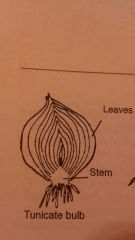
Tunicate bulbs |
Have thin, papery covering, which actually is a modified leaf which protects the bulb from damage and from drying once dug up. |
|
|
|
Nontunicate bulb |
Do not have papery modified leaf covering. Very susceptible to drying and damage. |
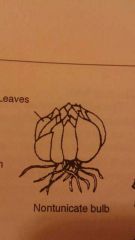
|
|
|
Tuberous root |
An underground storage organ made up of root tissue. Sprouts only from the point at which it was attached to the stem of the parent plant. Example: dahlias |
|
|
|
Bulblet |
1) an underground bulbil 2) a tiny bulb produced at the base of a mother bulb. |
|
|
|
Bulbil |
A small bulb - like organ that sometimes forms in place if flowers. |
|
|
|
Cane |
An externally woody, internally pithy stem of a bramble or vine. |
|
|
|
Pith |
a tissue in the stems of vascular plants composed of soft, spongy cells, which store and transport nutrients throughout the plant. The pith is encircled by a ring of xylem; the xylem, in turn, is encircled by a ring of phloem. |
|
|
|
Aerial roots |
Roots above the ground Example: poison ivy |
|
|
|
Vine |
A plant with long trailing stems. |
|
|
|
Leaf bud |
Composed of a short stem with embryonic leaves. Less plump and more pointed than flower buds. |
|
|
|
Flower bud |
Composed of a short stem with embryonic flower parts. |
|
|
|
Terminal buds |
Located at the apex of a stem. |
|
|
|
Axillary buds |
Located on the sides of a stem and usually arise where a leaf meets a stem (axil). Aka lateral buds |
|
|
|
Adventitious buds |
Arise at sites other than the terminal and axillary position. May develop from roots, a stem internode; the edge of a leaf blade or callus tissue at the cut end of a stem or root. They allow stem, leaf, and root cuttings to develop into entirely new plants. |
|
|
|
Petiole |
The stalk that attaches a leaf to a stem. |
|
|
|
Adventitious root |
A root that develops in an unusual place; often where a branch contacts soil or damp material. A plant cannot be reproduced from cuttings or layering unless adventitious roots develop. |
|
|
|
Sessile |
Stalkless and attached directly at the base, as in sessile leaves. |
|
|
|
Pubescent |
Hairy |
|
|
|
Cuticle |
1) a relatively impermeable surface layer on the epidermis of leaves and fruits 2) the outer layer of an insects body |
|
|
|
Cutin |
1) a waxy substance on plant surfaces that tends to make te surface waterproof and can protect leaves from dehydration and disease. 2) a waxy substance on an insect's cuticle that protects the insect from dehydration. |
|
|
|
Guard cell |
Leaf epidermis cells that open and close to let water, oxygen, and carbon dioxide pass through the stomata. |
|
|
|
Mesophyll |
A leaf's inner tissue, located between the upper and lower epidermis, where raw materials (carbon dioxide and water vapor) are held for use in photosynthesis. |
|
|
|
Chloroplast |
A specialized component of certain cells. Contains chlorophyll and is responsible for photosynthesis. |
|
|
|
Bracts |
A modified leaf, usually small, but sometimes large and brightly colored, growing at the base of a flower or on its stalk. Example: dogwood and poinsettia |
|
|
|
Pinnate venation |
Veins extend laterally from mid rib to the edge.
Example: apples, cherries, peaches. |
|
|
|
Palmate venation |
Principal veins extend outward, like the ribs of a fan, from the base of the leaf blade. Example: grapes, maples |
|
|
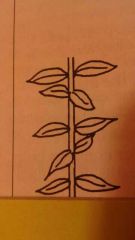
|
Opposite leaf arrangement |
|
|
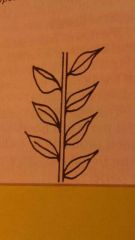
|
Alternate leaf arrangement |
|
|
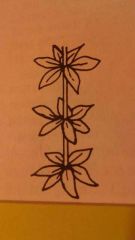
|
Whorled leaf arrangement |
|
|

|
Rosulate leaf arrangement |
|
|
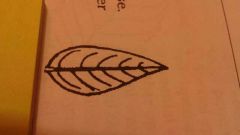
|
Lanceolate blade shape |
Longer than wide and tapering toward the apex and base. |
|

|
Linear blade shape |
Narrow, several times longer than wide and of approximately the same width throughout. |
|

|
Cordate blade shape |
Broadly ovate, tapering to an acute apex, with the base turning in and forming a notch where the petiole is attached. |
|

|
Elliptical blade shape |
About two or three times as long as wide, tapering to an acute or rounded apex and base. |
|
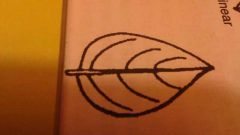
|
Ovate blade shape |
Egg shaped, basal portion wide, tapering toward the apex. |
|
|
Stigma |
The part of the female sex organ that receives pollen. Supported by the style, through which it is connected to the ovary. Often sticky when receptive. |
|
|
|
Style |
The part of the female sex organ that supports the stigma and connects it to the ovary. |
|
|
|
Pistil |
The female sexual organ of a flowering plant, made up of the stigma, style and ovary. |
|
|
|
Anther |
The polken-bearing part if a flower's male sexual organ. The filament supports the anther; together they are referred to as the stamen. |
|
|
|
Stamen |
The male, pollen producing part of a flower consisting of the anther and it's supporting filament. |
|
|
|
Filament |
The stalk supporting a flower's anther. |
|
|
|
Sepal |
An appendage at a flower's base, typically green or greenish and more or less leafy in appearance. Collectively, the calyx. |
|
|
|
Calyx |
The collective term for the sepals (the cup, usually green, between flower and its stem). |
|
|
|
Pedicel |
The stem of an individual flower. |
|
|
|
Ovary |
The part of a flower containing ovules that will develop into seeds upon fertilization. Along with the style and stamen, it makes up the pistil. |
|
|
|
Corolla |
Collectively, all of a flower's petals. |
|
|
|
Monoecious |
A species having both male and female flowers on the same plant. Example: pecans, avocadoes, squash |
|
|
|
Dioecious |
A species having male and female flowers on separate plants. Exampe: holly |
|
|
|
Inflorescence collective |
A group of individual flowers. The grouping can take many forms. |
Spike, umbel or corymb, panicle, or capitulum. |
|
|
Floret |
What each flower in an inflorescence is called. |
|
|
|
Racemes |
Florets start blooming from the bottom of the stem and progress toward the top. |
|
|
|
Cymes |
A flower stalk on which the florets start blooming from the top of the stem and progress toward the bottom. |
|
|
|
Simple fruit |
Develop from a single ovary. Example: cherries, peaches, pears, apples, tomatoes. |
|
|
|
Aggregate fruit |
Develop from a single flower with many ovaries. Examples: strawberries, raspberries, blackberries. |
|
|
|
Multiple fruits |
Derived from a tight cluster of separate, independent flowers borne on a single structure. Each flower has its own calyx and corolla. Examples: figs, pineapple |
|

